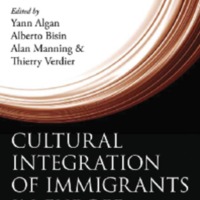Cultural Integration of Immigrants in Europe
Dublin Core
Subject
Description
The concepts of cultural diversity and cultural identity are at the forefront of the political debate in many western societies. In Europe, the discussion is stimulated by the political pressures associated with immigration flows, which are increasing in many European countries. The imperatives that current immigration trends impose on European democracies bring to light a number of issues that need to be addressed. What are the patterns and dynamics of cultural integration? How do they differ across immigrants of different ethnic groups and religious faiths? How do they differ across host societies? What are the implications and consequences for market outcomes and public policy? Which kind of institutional contexts are more or less likely to accommodate the cultural integration of immigrants? All these questions are crucial for policy makers and await answers. This book aims to provide a stepping stone to the debate. Taking an economic perspective, this edited book presents a current, comparative picture of the process of cultural integration of immigrants across Europe. It documents the main economic debates on the causes and consequences of cultural integration of immigrants, and provides detailed descriptions of the cultural and economic integration process in seven main European countries, including France, Germany, Italy, Spain, Sweden, Switzerland, and the United Kingdom. It also compares the European context with the integration of immigrants in the United States.
Source
http://oapen.org/download?type=document&docid=453470
Publisher
Contributor
Rika Zulfia
Rights
Creative Commons
Type
Files
Citation
Yann Algan, et al., “Cultural Integration of Immigrants in Europe,” Open Educational Resources (OER) , accessed January 16, 2026, http://oer.uinsyahada.ac.id/items/show/496.


